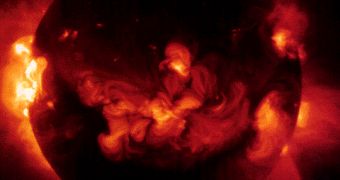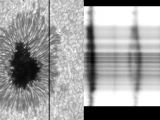At last, after so many millennia of browsing in the dark for facts related to our own star, we're finally getting closer to knowing the sun directly, not by making suppositions. NASA scientists are currently preparing for the task of exploring "the transition region" of the sun, basically the place where space weather forms.
This "transition region" defines an atmospheric zone 5.000 km above the surface of the sun where magnetic fields are stronger than matter pressure and influence the movement of sun gases, causing solar flare explosions, wind accelerations of about 1.6 million km/h (1 million mph) and sending the ejections of the coronal mass towards the planets in the system.
Researchers will gather data about the "secret layer" by means of "Zeeman splitting," a physical effect discovered by Dutch physicist Pieter Zeeman back in 1896, which refers to the way a spectral line splits into a number of components under the influence of a static magnetic field (a phenomenon characteristic to ferrous materials, which is caused by moving electric charges). The spectral line, bright or dark, appears inside a uniform and continuous spectrum as a result of a photon excess or deficiency in a narrow frequency range, in comparison with the neighboring frequencies.
Perhaps describing how Zeeman got to discover the effect that bears his name will help you better understand visually what happens in the process. When the physicist entered an incandescent gas-filled tube into a magnetic field, the spectral lines that the gas emitted got split into 2 slightly different colors. The color difference increased with the power of the magnetic field. This is the phenomenon that will help NASA experts gather data about the "transition region" of the sun. This has been done before, but not in the respective region of the sun and not from outside Earth's atmosphere, as it will be done now. This picture shows spectral lines formed by a sunspot's magnetic field in a mass of gaseous iron.
Jonathan Cirtain from MSFC (Marshall Space Flight Center) tells PhysOrg that "Early next year, we're going to launch an experimental telescope that can measure vector magnetic fields in the transition region." People at MSFC developed the SUMI telescope (Solar Ultraviolet Magnetograph Investigation) because, as Cirtain says, "Gas in the transition region doesn't produce many strong spectral lines that we can see at visible wavelengths. That's why we have to leave Earth." The respective wavelengths will be visible from outside our planet's atmosphere. SUMI is set to be launched in April 2009 from White Sands, New Mexico.
It will be carried by a Black Brant rocket to 300km above Earth at about 8000km/h (5.000 mph). Upon reaching that point in space, there will only be a narrow time corridor of 8 minutes in order to perform the whole experiment. Cirtain already dreads them: "Eight minutes of terror." As to what exactly will happen, he explains: "We'll target an active region and start taking data."
The scientists will measure the gap in the layer, calculating the magnetic field strength in the sunspot. Furthermore, by observing the split line's polarization, they'll also be able to reach their other goal – deducing the field's direction.
It is highly possible that no major discoveries will be made right away, "but it will demonstrate the SUMI concept and show us if it's going to work," Cirtain says, and maybe if all goes well, more missions of this kind will take place, perhaps culminating with the permanent installation of such a magnetograph on a future space telescope.

 14 DAY TRIAL //
14 DAY TRIAL // 
